Freediving, also known as breath-hold diving, is the practice of diving underwater without the use of breathing apparatus such as scuba gear. Freedivers rely solely on their own physical ability to hold their breath and control their breathing to stay underwater. The physiology and psychology of freediving are closely related, as they both involve the control of the body and mind during the dive. Physiologically, freediving requires a high level of physical fitness and training to increase lung capacity, cardiovascular efficiency, and muscle strength.
Mental preparation is also crucial for freediving as it requires a high level of focus, discipline, and control over the body. This can be achieved through visualization techniques, mindfulness, and relaxation exercises. One key component of freediving training is learning proper breathing techniques. This includes learning how to breathe deeply and efficiently to increase the amount of oxygen in the lungs and reduce the amount of carbon dioxide. Training also includes learning how to hold the breath for extended periods of time and how to recover quickly after a dive. Another important aspect of freediving is equalization, or the act of maintaining equal pressure between the ears and sinuses and the surrounding water. This is necessary to prevent injury to the ears and sinuses caused by the difference in pressure between the water and the air spaces in the head. There are several methods used for equalization while freediving. The most common method is the "Valsalva maneuver," which involves pinching the nose and blowing gently to force air into the Eustachian tubes that connect the middle ear to the back of the throat. Another method is the "Frenzel maneuver" which involves tensing the muscles at the back of the throat to force air into the Eustachian tubes. A third method is the "Toyota maneuver" which involves swallowing while pinching the nose. Freediving also requires proper technique and body positioning. This includes keeping the body as streamlined as possible to reduce drag and conserve energy, and using the fins or hands to propel the diver forward. Freediving is a challenging and potentially dangerous sport, and it is important for individuals to take proper safety precautions and obtain proper training before attempting to freedive. This includes learning proper rescue techniques, and always diving with a partner who is trained in rescue and first aid. In addition to the physiological and psychological preparation, freedivers also need to be familiar with the conditions of the water they are diving in and to be aware of any potential hazards. This includes understanding the water currents, visibility, and marine life, as well as being aware of any risks such as hypothermia, hyperventilation, blackout, and other diving-related accidents. Freediving is a challenging and rewarding sport that requires a high level of physical and mental preparation. It requires learning proper breathing techniques, equalization methods, and body positioning to safely and comfortably dive underwater. It is important to take safety precautions and to seek proper training before attempting to freedive, and to always be aware of the conditions and potential hazards of the dive Seapixels now teaches basic freediving that can be done at either our local Lake or at the island. Please drop us an email to inquire more about PFI basic freediving at terence@seapixels.org
Carbon fiber fins and normal fins, also known as plastic or rubber fins, are both used in freediving, but they have some distinct differences in terms of materials, performance, and cost.
Carbon fiber fins are made from a composite of carbon fibers and epoxy resin. They are known for being lightweight, stiff, and strong. They are also highly responsive, meaning they can generate a lot of power with minimal effort. This makes them a popular choice among experienced freedivers and competitive freedivers, who require a fin that can generate a high level of propulsion and maneuverability. Carbon fiber fins are also known for their durability and resistance to wear and tear.
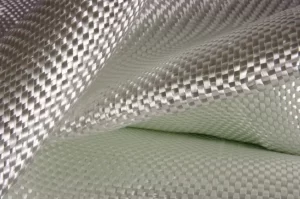
Normal fins, on the other hand, are typically made from plastic or rubber. They are generally less expensive than carbon fiber fins, and are known for being more flexible and less stiff than carbon fiber fins. They are also generally heavier than carbon fiber fins. This makes them a good option for beginners, who may not have the strength and technique to effectively use a stiffer fin. Normal fins also have a tendency to be less expensive than carbon fiber fins. The main pros of Carbon fiber fins are that they are lightweight, stiff, and strong. They are also highly responsive and generate a lot of power with minimal effort. They are also durable and resistant to wear and tear. The main cons of Carbon fiber fins are that they are more expensive than normal fins, and they may be too stiff for some divers to use effectively. The main pros of normal fins are that they are more flexible and less stiff than carbon fiber fins, and they are generally less expensive than carbon fiber fins. The main cons of normal fins are that they are heavier than carbon fiber fins, and they may not generate as much propulsion and maneuverability as carbon fiber fins.
Carbon fiber fins and normal fins are both used in freediving, but they have some distinct differences in terms of materials, performance, and cost. Carbon fiber fins are known for being lightweight, stiff, and strong, and are popular among experienced freedivers and competitive freedivers. Normal fins, on the other hand, are generally less expensive than carbon fiber fins, and are known for being more flexible and less stiff. Both types of fins have their pros and cons, and the best choice will depend on the diver's experience, strength, and budget. Seapixels now offer Freediving courses under PFI (performance freediving international) Do email us for more details at Terence@seapixels.org
![]()
The ocean is one of the most important and diverse ecosystems on Earth, but it is also one of the most threatened by pollution. Pollution in the ocean poses a significant danger to marine life, and ultimately affects human health and economies. The main causes of ocean pollution are:
-
Plastic waste: Plastic is one of the most common and persistent pollutants in the ocean. It can take hundreds of years to degrade, and it harms and kills marine animals, including sea turtles, whales, and birds.
-
Oil spills: Oil spills can occur from natural seeps, oil tankers, and offshore drilling operations. They can cause devastating harm to marine life and their habitats, as well as to coastal communities and economies.
-
Chemical pollution: Chemicals such as pesticides and fertilizers that are used on land can run off into rivers and eventually reach the ocean. These chemicals can be harmful to marine life and can cause changes in the ocean's chemistry.
-
Noise pollution: Underwater noise from shipping, oil and gas exploration, and other human activities can harm marine life, especially dolphins and whales, which rely on sound to communicate, navigate, and find food.
A Gray Triggerfish, Balistes capriscus, hovers below garbage floating in the open Atlantic offshore Palm Beach, Florida.
The dire effects of ocean pollution include:
-
Marine life death and injury: Pollution can harm and kill a wide range of marine species, from tiny plankton to large whales. Plastic, oil, and chemicals can suffocate, poison, or entangle marine animals, and noise pollution can disrupt their behaviors and livelihoods.
-
Ecosystem disruption: Pollution can disrupt and degrade the ocean's ecosystems, from coral reefs to kelp forests, by altering the abundance and diversity of species, and changing the ocean's chemistry and temperature.
-
Human health impacts: Pollution can also affect human health, especially for those who depend on seafood for food and livelihoods, or who live or work in coastal communities. Polluted seafood can contain harmful chemicals, and exposure to oil and chemicals can cause skin irritation, respiratory problems, and other health issues.
-
Economic impacts: Pollution can also harm the ocean-related industries, such as fishing, tourism, and recreation, and can cost billions of dollars in damages and cleanup.
To prevent or curb pollution in the ocean, several solutions can be implemented:
-
Reduce plastic use: individuals can reduce the use of single-use plastics such as straws, bags, and bottles, and recycle or properly dispose of plastic waste. Governments can also implement policies to reduce plastic use and promote recycling.
-
Improve waste management: Governments can implement policies to improve waste management infrastructure and regulations to prevent plastic, oil, and other pollutants from entering the ocean.
-
Regulate and monitor industrial activities: Governments can regulate and monitor industrial activities, such as oil and gas exploration and shipping, to minimize the risk of spills and other accidents and to hold responsible parties accountable.
-
Support ocean conservation: Governments, organizations and individual can support ocean conservation efforts, such as marine protected areas and sustainable fisheries, to protect marine life and habitats from pollution and other threats.
In terms of countries that contribute the most to ocean pollution, it is difficult to pinpoint one specific country as the main contributor due to the complex and global nature of ocean pollution. However, according to a study by the Ocean Conservancy and the McKinsey Center for Business and Environment, the top five countries responsible for the most mismanaged plastic waste are China, Indonesia, Philippines, Vietnam, and Sri Lanka. These countries are responsible for over 55% of plastic waste leakage into the ocean. In contrast, the countries that contribute the least to ocean pollution are those that have strong regulations and enforcement mechanisms in place to prevent pollution from entering the ocean. So divers and all, PLEASE SAVE OUR ONE AND ONLY OCEAN :)
Sipadan Island
Sipadan Island, located in the Celebes Sea off the coast of Sabah, Malaysia, is considered one of the best diving destinations in the world. The island is renowned for its crystal clear waters, diverse marine life, and spectacular coral reefs. Divers of all levels can enjoy the beauty of Sipadan's underwater world and experience the thrill of diving in one of the most biodiverse places on earth.The underwater world of Sipadan is truly breathtaking. The island's coral reefs are home to an incredible variety of marine life, including over 3,000 species of fish, hundreds of species of coral, and countless other forms of marine life. Divers can expect to see large schools of colorful tropical fish, sea turtles, sharks, and even the occasional manta ray or whale shark. The island's dive sites are also home to a wide variety of hard and soft coral, making for some truly spectacular diving. For those interested in diving in Sipadan, there are a variety of scuba diving training options available. Many dive centers on the island offer SDI , PADI and SSI certified scuba diving courses, from open water to advanced, and even technical diving courses. These courses will provide you with the skills and knowledge needed to safely and responsibly explore the island's underwater world.
Barracuda Point, Sipadan
When it comes to logistics, Sipadan Island is a bit more challenging to reach compared to other dive destinations in Malaysia. The island itself is uninhabited, and there are no accommodations or restaurants on the island, so divers will need to stay on nearby Mabul or Kapalai islands. From there, divers will be able to take a boat to Sipadan Island for diving. It's important to note that the number of divers allowed on the island is restricted to 250 per day, so it's important to book your trip in advance.
Bumphead parrot fish, drop off point, Sipadan
Sipadan Island is truly a diving paradise. The island's underwater world is simply breathtaking, and the marine life is diverse and abundant. We at Seapixels offer two option to dive at Sipadan. 1. Firefly resort which is land base at mainland Semporna, where divers will driven to the jetty daily for 3 dives before heading back to resort. 2. Borneo Divers which is a resort located in Mabul island, where divers will return to resort after every dives for surface interval. Just drop us an email for further inquiries should you wish to fulfill your dream of diving at one of the world top dive sites. Terence@seapixels.org or Pagan@seapixels.org
One of the main attractions of technical wreck diving is the opportunity to explore the history and mystery of sunken ships and other structures. These underwater time capsules offer a glimpse into the past and a chance to discover artifacts and treasures that have been lost for decades or even centuries. In addition to the historical and archaeological significance of these sites, technical wreck divers also enjoy the thrill of penetration diving, the challenge of navigating and mapping the wreck, and the opportunity to see marine life that has made the wreck its home. Diving wrecks requires specialized training, equipment, and experience. Here are some key steps and equipment that are needed for wreck diving:
-
Training: Wreck diving is considered a more advanced form of diving and requires specialized training. Many dive organizations, such as TDI and SSI, offer wreck diving courses that teach divers the skills and knowledge needed to safely and responsibly explore wrecks. These courses typically cover topics such as wreck diving regulations, safety procedures, navigation, and penetration diving.
-
Equipment: Wreck diving requires specialized equipment to ensure safety and comfort. Some of the essential equipment for wreck diving includes:
-
a full wetsuit or drysuit: to protect against cuts, scrapes, and the colder water found at deeper depths
-
a diving flashlight: for exploring the inside of wrecks and illuminating the way
-
a dive reel or line: to help divers navigate the wreck and mark the way out
-
a dive knife or cutting tool: for cutting away any entanglement
-
a dive computer or depth gauge: to monitor depth and time, and avoid decompression sickness
-
a compass: for navigation and maintaining a sense of direction
-
a signaling device: such as a whistle or dive slate, to communicate with your dive partner
-
a backup dive light and a dive watch with a timer
-
a diving torch, backup dive light, and dive watch with a timer
-
a back-up air supply, in case of emergency, such as a pony bottle or a spare scuba cylinder
-
a dive partner: wreck diving is generally considered a team sport, and it is recommended to always dive with a partner.
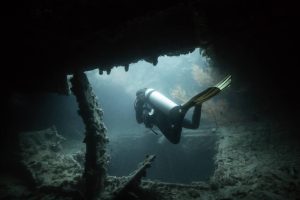
-
Planning and Preparation: Before diving a wreck, it's important to plan and prepare thoroughly. This includes researching the wreck, including its history and location, and obtaining any necessary permits or permissions. Divers should also review diving tables or use a dive computer to plan the dive and ensure that they stay within safe limits for depth and time.
-
Dive Procedures: Once in the water, divers should follow established dive procedures to ensure safety and minimize impact on the wreck and its environment. This includes staying with a dive buddy, using a dive reel or line to navigate, and avoiding touching or removing artifacts. Divers should also be aware of their air supply and use their dive computer or depth gauge to monitor their depth and time.
-
Emergency Procedures: Finally, it's important to be prepared for emergencies and to have a plan in case of an accident. This includes having a dive buddy, carrying a signaling device, and knowing the location of the nearest emergency services.
Wreck diving is an exciting and challenging type of diving that offers the opportunity to explore history, marine life and uncover artifacts and treasures that have been lost for decades or even centuries. It is crucial to have the right training, equipment and to plan, prepare and follow the established dive procedures in order to dive safely. With the right preparation and training, wreck diving can be a rewarding and unforgettable experience Southeast Asia is home to a variety of shipwrecks and other underwater structures that offer excellent opportunities for wreck diving. Here are some of the best wreck diving sites in Southeast Asia:
USS Liberty , sank in 1944
-
The Liberty shipwreck in Bali, Indonesia: This American ship was built in the 1940s and was sunk by the Japanese during World War II. The wreck now lies in about 30 meters of water and is home to a variety of marine life, making it a popular spot for both recreational and technical divers. We at Seapixels frequent this wreck and the resort we are staying at Pebbles and Fins offers both leisure and technical diving.
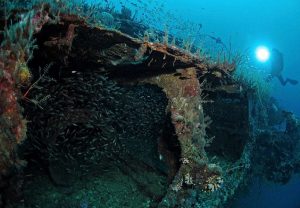
I 66 Japanese Submarin, sank in 1944
-
The I-66 submarine in Sipadan, Malaysia: This Japanese submarine was sunk by the Allies during World War II and now lies in about 40 meters of water. The I-66 is considered one of the best wreck dives in Southeast Asia and offers a unique opportunity to explore the inside of a submarine.
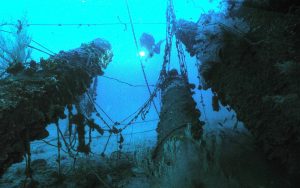
HMS Repluse, sunk in 1959
-
The HMS Repulse in Tioman Island, Malaysia: This British merchant ship was sunk by the Japanese during World War II and now lies in about 30 meters of water. The wreck is home to a variety of marine life and offers a glimpse into the history of the war in Southeast Asia.
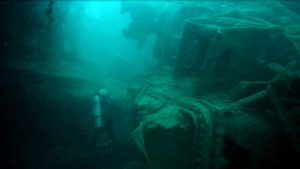
Australian National Maritime Museum HMAS Perth dive 2017
-
The HMAS Perth in Indonesia: This Australian cruiser was sunk by the Japanese during World War II and now lies in about 30 meters of water. The Perth offers a variety of penetration opportunities, including the ship's engine room and gun turrets.
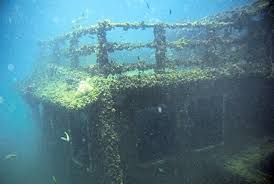
USS Salute, sunk in 1942
-
The USS Salute in Subic Bay, Philippines: This American mine-laying ship was sunk by the Japanese during World War II and now lies in about 30 meters of water. The Salute offers a variety of penetration opportunities, including the ship's engine room and bridge.

The S.S. Thorfinn in Mergui Archipelago,Myanmar
-
The S.S. Thorfinn in Mergui Archipelago,Myanmar: This British merchant ship was sunk by the Japanese during World War II and now lies in about 30 meters of water. The Thorfinn offers a variety of penetration opportunities, including the ship's engine room and holds.
These are just a few examples of the many incredible technical wreck dive sites that are available around the world. Each site offers its own unique challenges and rewards, and many technical divers choose to specialize in specific types of wrecks, such as WWII ships, submarines, or planes.
Lang Tengah newly Submerged Plane
It's important to note that Technical Wreck Diving is a complex and challenging type of diving that requires extensive training, equipment, and experience. It is not recommended for novice divers and should only be attempted by divers who have completed the relevant training and have the necessary experience and skills. TDI Courses provides full extensive Wreck courses or plan your courses with us at Seapixels. We at Seapixels can start your journey into Wreck Diving with Sidemount and Nitrox. Drop us an email at Terence@seapixels.org for more details.
![]()
Technical diving is a type of diving that goes beyond the limits of recreational diving and requires specialized training and equipment. It involves diving in environments or at depths that are beyond the scope of recreational diving, and often involves the use of specialized gases and diving techniques. Technical diving can include a wide range of activities, such as cave diving, wreck diving, deep diving, and more. Technical diving requires a high level of skill, knowledge, and physical fitness, as well as a commitment to safety. It is not a pursuit for the casual or inexperienced diver, and requires extensive training and experience to master.Training for technical diving typically begins with an introduction to the basic concepts and principles of technical diving. This can include topics such as dive planning, gas management, decompression theory, and emergency procedures. From there, divers can progress to more advanced training, such as cave diving, deep diving, or wreck diving.
One of the key aspects of technical diving is the use of specialized equipment and gases. This can include the use of multiple tanks, which allow divers to carry a larger volume of gas and extend their dive time. It can also involve the use of specialized breathing gases, such as trimix (a mixture of oxygen, helium, and nitrogen), which can help divers to avoid the effects of nitrogen narcosis at deeper depths.
In addition to specialized equipment and gases, technical diving also requires a high level of planning and risk management. Divers must carefully plan their dives, taking into account factors such as depth, time, gas usage, and emergency procedures. They must also be prepared to deal with a wide range of potential emergencies, including out-of-air situations, equipment failures, and more.
Technical diving is not for everyone, and it requires a high level of skill, knowledge, and physical fitness. However, for those who are willing to put in the time and effort to master these skills, it can be an incredibly rewarding and exciting pursuit. Technical diving allows divers to explore the underwater world in ways that are not possible with recreational diving, and it can open up a whole new world of adventure and discovery.
We at Seapixels would love to bring you to explore the Technical world starting with Sidemount, Nitrox and Advanced Nitrox before we progress to other Technical Disciplines. Free Free to chat with us at Terence@seapixels.org or message us at +60163225555
Nudibranchs, also known as sea slugs, are a type of marine mollusk that belong to the class Gastropoda. They are known for their bright colors and unique, often bizarre, shapes and patterns. With over 3,000 known species, nudibranchs can be found in a wide range of marine environments around the world, from shallow coral reefs to deep sea trenches. One of the most striking features of nudibranchs is their appearance. Many species have vibrant and colorful bodies, which can range from shades of orange, red, and yellow to bright blue, purple, and green. These colors are often used for camouflage or as a form of warning to predators, as many nudibranchs are toxic or distasteful to eat. Some species even have elaborate frills, tentacles, or other appendages that add to their distinctive appearance.
Despite their small size – most nudibranchs are less than a few inches long – they are highly adaptable and have evolved a number of unique behaviors and characteristics to survive in their environments. Many species are carnivorous, feeding on a variety of prey including sponges, coral, and other invertebrates. Some species have even developed the ability to consume and retain the toxins and stinging cells of their prey, which they can then use as a defense against predators. Nudibranchs have a unique reproductive system, with both males and females having both male and female reproductive organs. This means that they can either fertilize their own eggs or fertilize the eggs of another individual. Many species lay their eggs in long, spiral-shaped clusters, which can contain hundreds or even thousands of eggs.
In addition to their interesting appearance and behaviors, nudibranchs are also important indicators of the health of marine ecosystems. Because they are sensitive to changes in their environment, the presence or absence of certain species can provide valuable information about the overall health of an ecosystem.
Despite their importance, nudibranchs are facing a number of threats, including habitat destruction, pollution, and the impacts of climate change. As a result, many species are listed as endangered or threatened, and conservation efforts are underway to protect these fascinating and important animals.
(Photo by : Martin Buschenreithner, with permission. http://slugsite.us/bow2007/nudwk857.htm) In conclusion, nudibranchs are a diverse and fascinating group of marine mollusks that are known for their bright colors and unique behaviors. From their ability to consume and retain toxins to their complex reproductive system, there is much to learn and appreciate about these amazing creatures. And with their importance as indicators of the health of marine ecosystems, it is crucial that we work to protect and conserve these animals for future generations. If you're a beginner or professional photographer and interested to take some specific Nudibranch, just drop us an email at Terence@seapixels.org, we will be glad to bring you to them.
![]()
Decompression sickness, also known as "the bends," is a potentially life-threatening condition that can occur when a diver ascends too quickly from a deep dive. It is caused by the rapid expansion of gases in the body, which can lead to a variety of symptoms including joint pain, skin rash, dizziness, and difficulty breathing. In severe cases, decompression sickness can result in paralysis, brain damage, and even death.Decompression sickness occurs when a diver spends a significant amount of time at depths greater than 40 feet, breathing compressed air. At these depths, the pressure is much greater than at the surface, and the body absorbs more nitrogen from the air. When the diver ascends, the pressure decreases and the nitrogen expands, forming bubbles in the body's tissues and blood. These bubbles can cause a variety of problems, depending on where they form. The most common symptoms of decompression sickness are joint pain and fatigue. These symptoms often occur in the elbows, shoulders, and knees, and can range from mild to severe. Other symptoms can include skin rash, dizziness, and difficulty breathing. In severe cases, decompression sickness can cause paralysis, brain damage, and even death. There are several factors that can increase the risk of decompression sickness, including the depth and duration of the dive, the type of diving equipment used, and the diver's physical condition. Divers who are older, obese, or in poor physical condition are at greater risk of developing the bends. In addition, diving at depths greater than 100 feet or diving for extended periods of time can increase the risk of decompression sickness.
To prevent decompression sickness, divers must follow proper dive procedures and use the correct equipment. This includes using a dive computer or dive tables to calculate the appropriate dive time and ascent rate, and using a dive watch or other device to monitor the dive. In addition, divers should avoid flying or traveling to high altitudes within 24 hours of diving, as the lower pressure at higher altitudes can cause gases to expand more rapidly.
If a diver does develop decompression sickness, it is important to seek medical treatment as soon as possible. Treatment for decompression sickness typically involves administering 100% oxygen and placing the diver in a hyperbaric chamber, which can help to reduce the size of the nitrogen bubbles and improve symptoms. In severe cases, the diver may need to undergo surgery to remove the gas bubbles. In conclusion, decompression sickness is a potentially life-threatening condition that can occur when a diver ascends too quickly from a deep dive. It is caused by the rapid expansion of gases in the body, and can lead to a variety of symptoms ranging from mild joint pain to severe paralysis and brain damage. To prevent decompression sickness, divers must follow proper dive procedures and use the correct equipment, and seek medical treatment if symptoms develop.
![]()
Buoyancy is an important aspect of scuba diving, as it determines how easily a diver can move through the water and control their depth. In simple terms, buoyancy is the ability of an object to float or sink in a fluid, such as water. When a diver is neutrally buoyant, they are able to hover in the water without sinking or rising, which allows them to move freely and conserve energy. There are several factors that affect a diver's buoyancy, including their body composition, the weight of their diving equipment, and the type of diving suit they are wearing. A diver's body composition can affect buoyancy because different tissues have different densities, with fat and muscle being less dense than bone. This means that a diver with a higher percentage of body fat may be more buoyant than a leaner diver.The weight of a diver's diving equipment, such as their scuba tanks, diving weights, and wet suit, can also affect buoyancy. A diver who is carrying too much weight may sink too easily, while a diver who is carrying too little weight may struggle to descend. The type of diving suit a diver wears can also affect buoyancy. Wet suits are made of neoprene, a synthetic rubber that is less dense than water. This means that a wet suit can provide some buoyancy to a diver, helping them to float more easily. However, wet suits can also trap small amounts of water inside, which can increase a diver's weight and decrease their buoyancy.
To control buoyancy while diving, divers can use a variety of techniques and equipment. One common technique is the use of diving weights, which are placed in pockets on the diver's weight belt or harness. Divers can add or remove weights to fine-tune their buoyancy, depending on the conditions of the dive. Another technique for controlling buoyancy is the use of a buoyancy control device (BCD), which is a piece of diving equipment that allows a diver to inflate or deflate a bladder of air to adjust their buoyancy. BCDs are worn on the diver's back and are connected to the scuba tank via a hose. By adjusting the amount of air in the bladder, a diver can make themselves more or less buoyant. In addition to these techniques and equipment, divers can also use proper breathing and finning techniques to control their buoyancy. Proper breathing involves exhaling as the diver descends and inhaling as they ascend, which can help to maintain a neutral buoyancy. Finning techniques, such as the frog kick or the flutter kick, can also help a diver to move through the water with greater control and efficiency. In conclusion, buoyancy is an important aspect of scuba diving that determines how easily a diver can move through the water and control their depth. There are several factors that affect a diver's buoyancy, including their body composition, the weight of their diving equipment, and the type of diving suit they are wearing. To control buoyancy, divers can use diving weights, BCDs, proper breathing and finning techniques, and other equipment and techniques. By mastering buoyancy, divers can enjoy greater control and freedom during their dives, and reduce the risk of accidents or injuries. We at Seapixels conduct regular buoyancy classes at the comfort of swimming pool where we can correct and advice all divers. Our methods of teaching is fun and quick to learn coming from 20 years of scuba experience. You'll definitely be correct weighted and your trimming and breathing will drastically improve as well. Just Drop us an email at terence@seapixels.org or message us at +60163225555 for more information on classes. Cheers